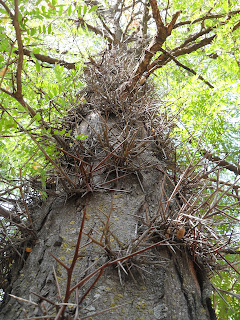The Oklahoma Academy of Sciences had its fall field meeting on the weekend of September 21-23 at Boiling Springs State Park and the Selman Living Lab of the University of Central Oklahoma. Nice weather made the 1.7 billion sandburs tolerable. There were numerous field trips, in addition to the renewal of old, and the making of new, friendships (which is always one of the best parts of a scientific meeting).
I went on the two botany trips led by Gloria Caddell of UCO. Anyone who went on a different trip and would like to write about it, please let David Bass know (dbass@uco.edu) and we can include it in this blog. Photographs are welcome.
The first trip was in the park itself, where Dr. Caddell showed us how to distinguish among superficially-similar composite plants and different grasses. We got to know the forest trees, including soapberry, Kentucky coffee tree, honey locust, black locust, netleaf hackberry, and green ash. I for one was surprised that the small-leaved elms were the same species (American elm) that grows in the eastern part of the state and throughout the eastern deciduous forest. We also saw the Oklahoma champion bur oak tree.
The Selman living laboratory, about twenty miles away, is on shortgrass prairie land with numerous gypsum outcrops. We could clearly distinguish zones (usually between outcrops) that had been grazed in recent decades and the gypsum outcrops. The outcrops had less dense vegetation, which is why the cows had avoided them; these outcrops had different species from the grazed zones, including Phacelia integrifolia, a wildflower mostly restricted to gypsum outcrops. One of the field trip participants cracked open some alabaster (crystalline gypsum) and found some cyanobacteria growing inside the translucent alabaster.
The Selman Lab, and to a lesser extent Boiling Springs, are exactly the kinds of places about which many of my students would say, “There’s nothing out here.” But I find it always inspiring to see how many different species of plants (and animals, which the herpetology group pursued) can survive in a hostile environment, and in so many different ways. Grasses, with thin leaves and deep roots, thrive in the same place as small cacti, with succulent stems and shallow roots.
Don’t forget to register (http://oas.uco.edu) for the Technical Meeting, which will be November 9 at UCO.
Field trip participants learn botany from Gloria Caddell.
Cyanobacteria grow underneath alabaster--inside of a rock.
The largest bur oak tree in Oklahoma.
Gleditsia triacanthos, the honey locust, has formidable thorns.




No comments:
Post a Comment